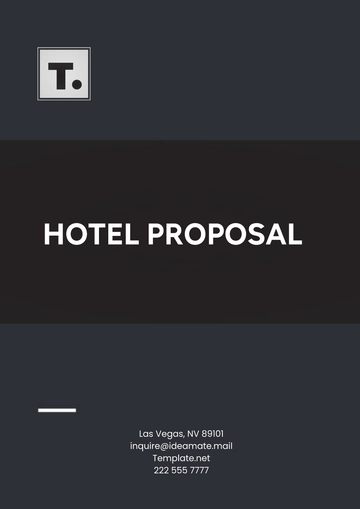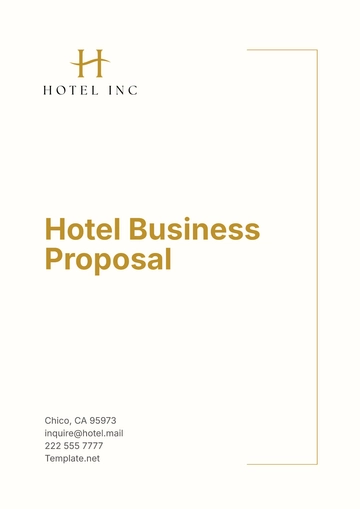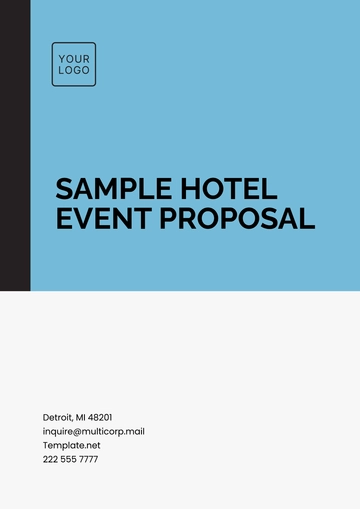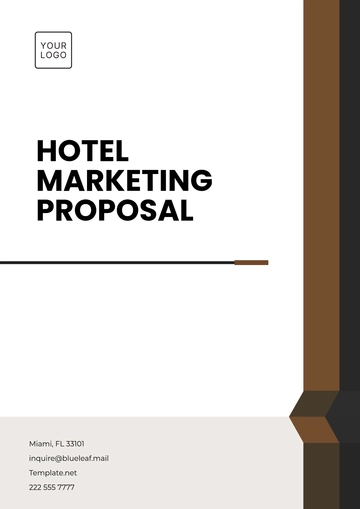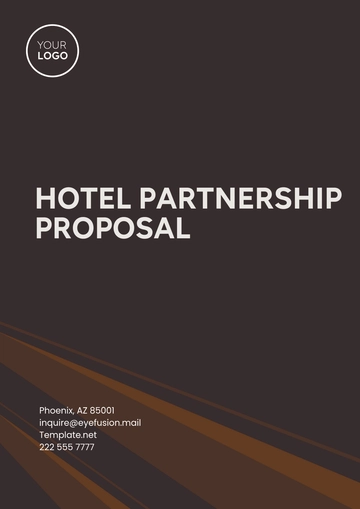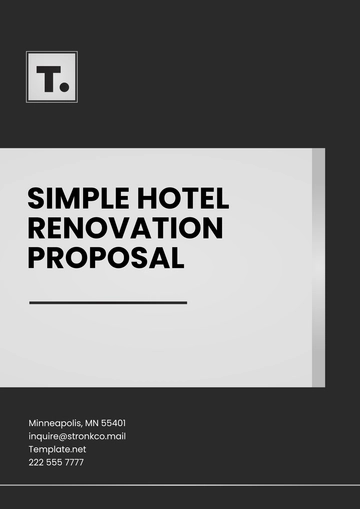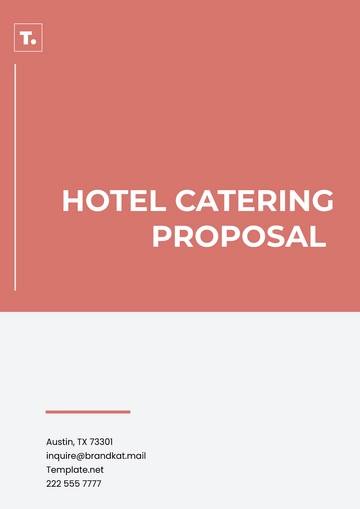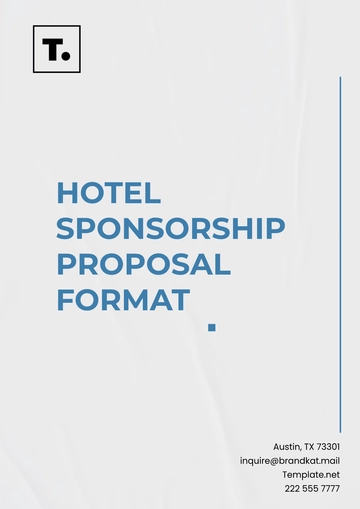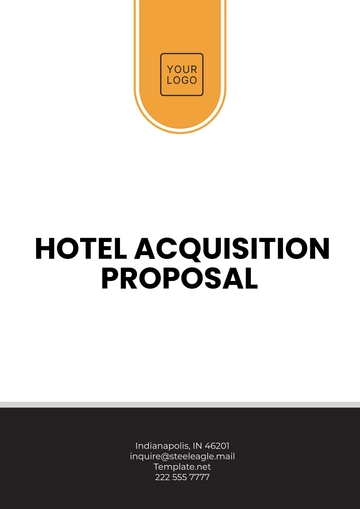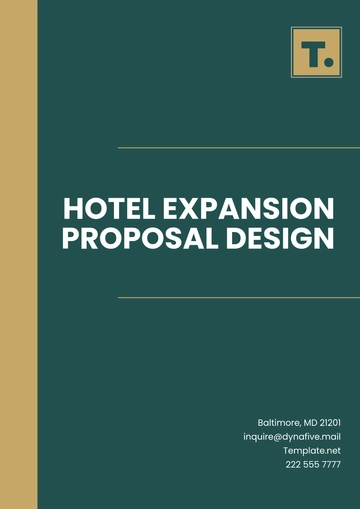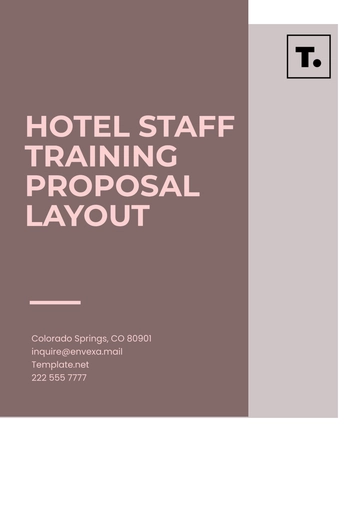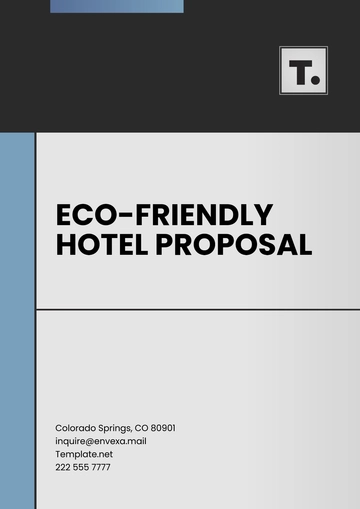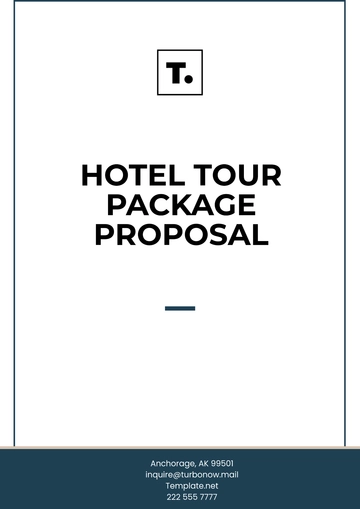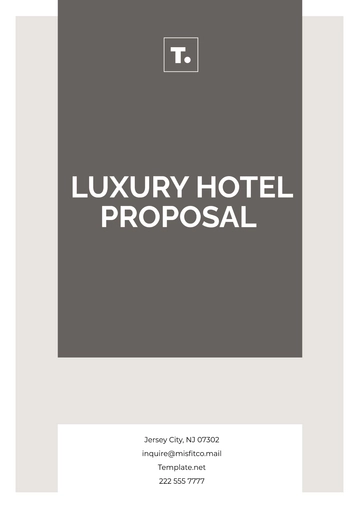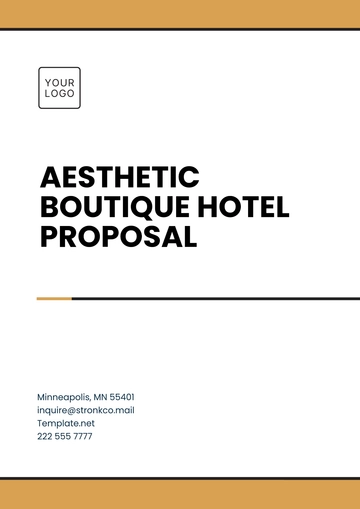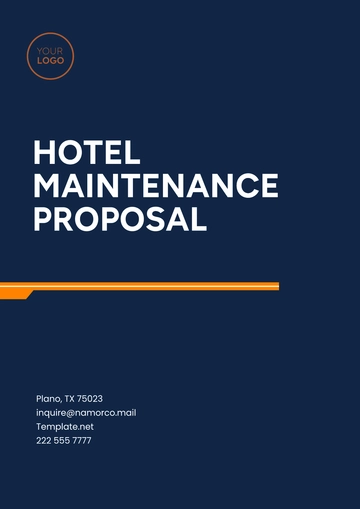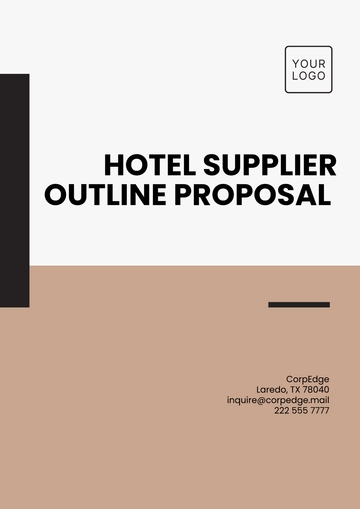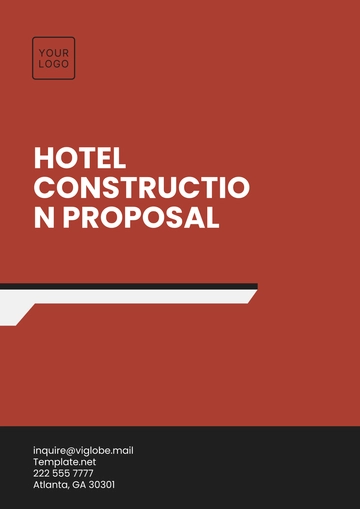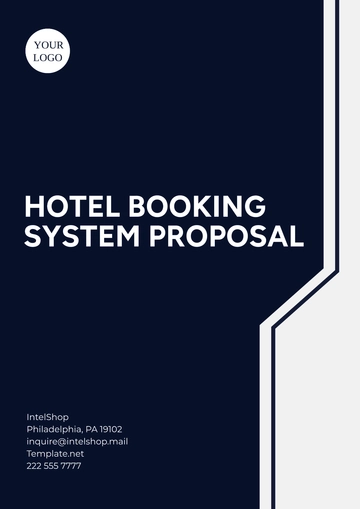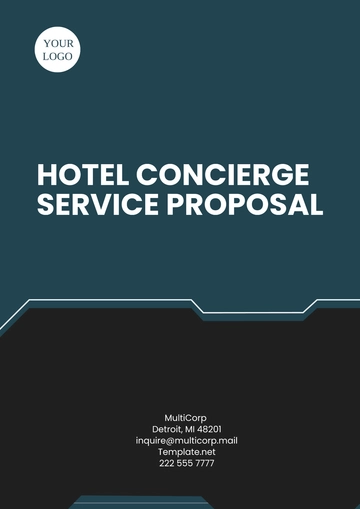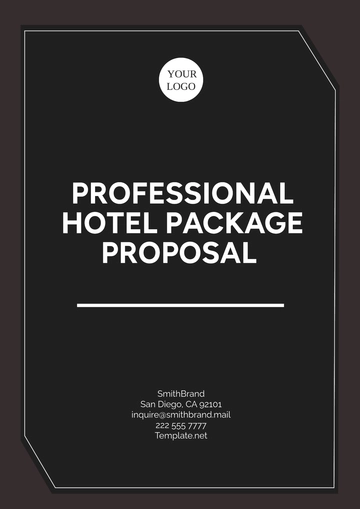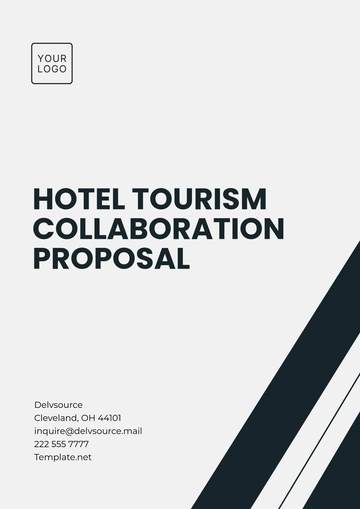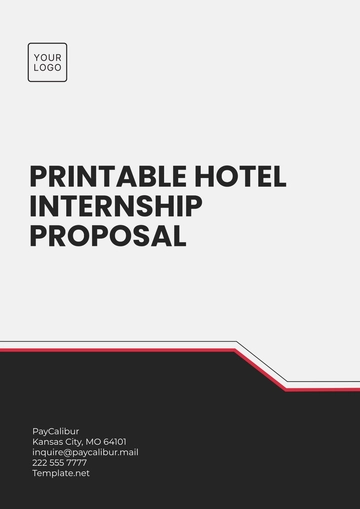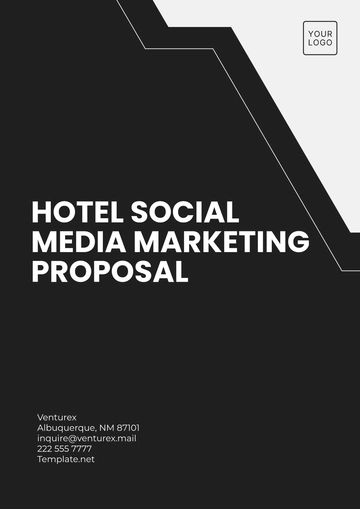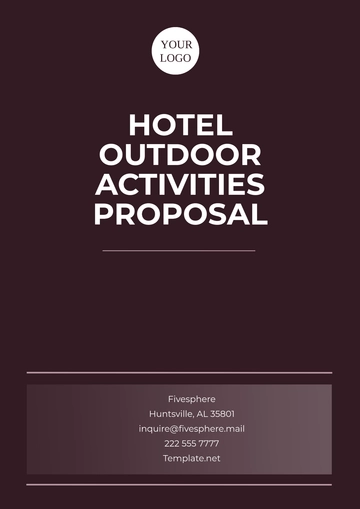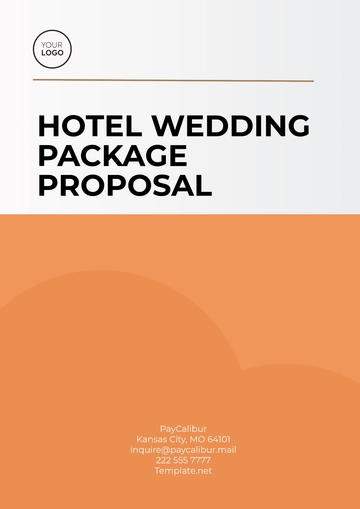Free Hotel Marketing Proposal
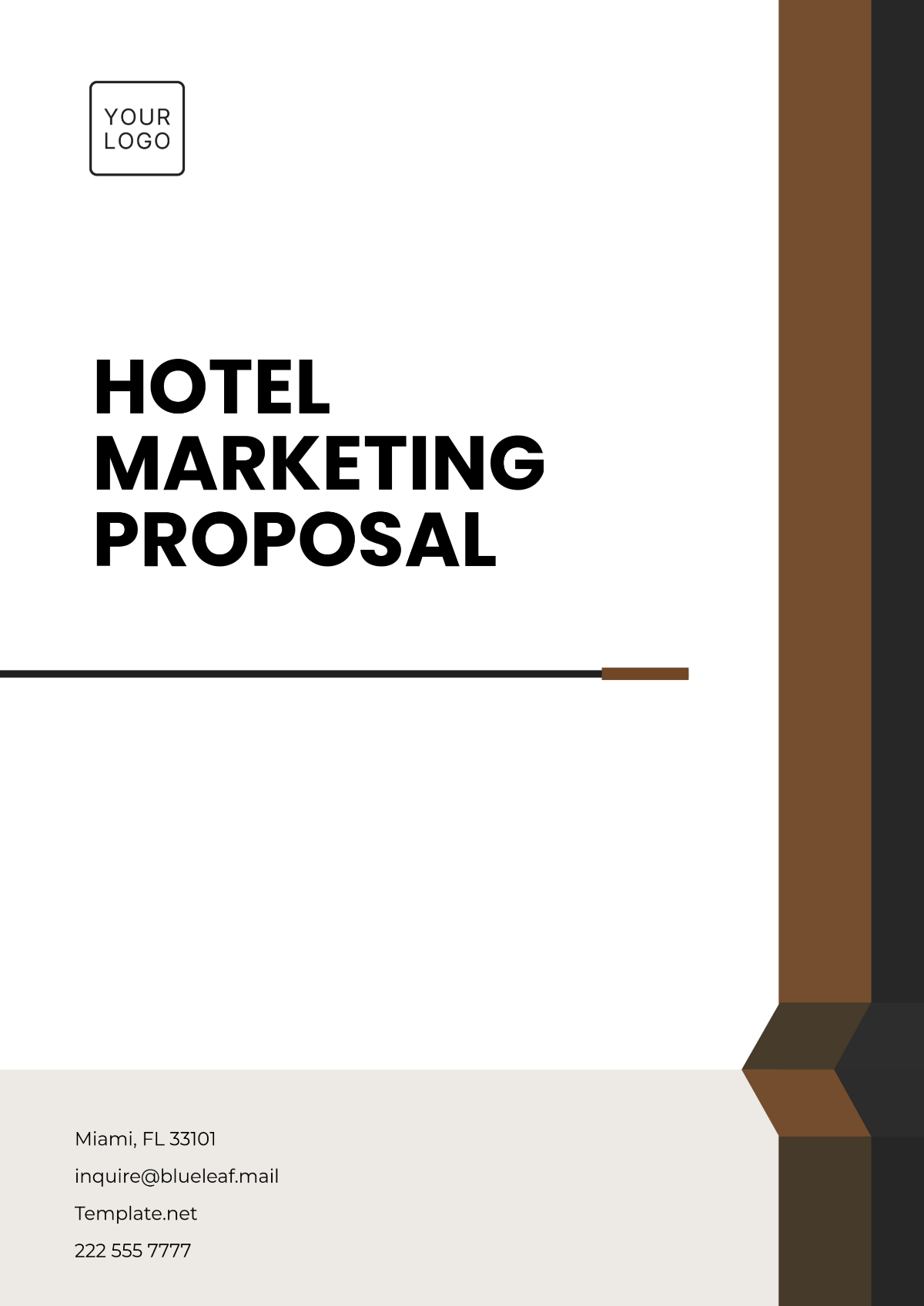
Prepared By: [Your Name]
I. Executive Summary
The purpose of this proposal is to outline a strategic marketing plan for [Your Company Name], a renowned hotel aiming to enhance its market presence and attract a diverse clientele. Our approach will focus on integrating modern marketing techniques with traditional strategies to elevate the hotel's brand recognition and stakeholder engagement.
II. Situational Analysis
A comprehensive analysis of the current market environment is crucial to tailor an effective marketing strategy for [Your Company Name]. By conducting a thorough examination of the hotel's strengths, weaknesses, opportunities, and threats (SWOT), we can pinpoint areas for growth and identify potential challenges that may impact our strategic initiatives.
Market Trends: Understanding the prevailing market trends is essential for staying competitive and meeting the evolving needs of our customers.
Sustainable Tourism: Increasing demand for eco-friendly accommodations and practices.
Digital Nomads: Rise in the number of remote workers seeking long-term stays.
Personalized Experiences: Growing preference for tailored and unique travel experiences.
Technological Advancements: Impact of technology on booking, customer service, and in-room experiences.
Competitive Landscape: Analyzing the competitive landscape provides insights into our hotel's position relative to our competitors.
Competitor Analysis: Evaluation of strengths and weaknesses of nearby hotels.
Market Gaps: Identification of unmet needs and potential market gaps.
Emerging Competitors: Recognition of new and upcoming competitors.
Pricing Strategies: Analysis of competitors' pricing models and service offerings.
Customer Satisfaction: Benchmarking customer satisfaction levels against competitors.
Customer Demographics and Preferences: A detailed understanding of our customer demographics and preferences enables us to tailor our services to meet their specific needs.
Primary Segments: Identification of key customer segments such as business travelers, leisure tourists, and event planners.
Segment Preferences: Understanding the unique preferences of each segment (e.g., high-speed internet for business travelers, family-friendly amenities for leisure tourists).
Customer Feedback: Analysis of customer reviews and feedback for service improvement.
Demographic Trends: Monitoring changes in demographics to adapt services accordingly.
Loyalty Programs: Development and enhancement of loyalty programs to increase customer retention.
Internal Capabilities and Resources: Assessing our internal capabilities and resources is critical for identifying areas where we can leverage our strengths and improve our weaknesses.
Staff Competencies: Evaluation of staff skills and areas for training and development.
Technological Infrastructure: Assessment of current technology systems and identification of upgrade needs.
Financial Health: Analysis of financial performance and budget allocation.
Operational Efficiencies: Identification of areas for improving operational processes.
Resource Allocation: Optimization of resource allocation to maximize effectiveness.
A. SWOT Analysis
To provide a structured overview of our situational analysis, we present the following SWOT analysis:
Strengths | Weaknesses |
|---|---|
Prime location in a popular tourist area | Limited parking space |
High customer satisfaction and strong brand reputation | Outdated technology systems |
A diverse range of amenities and services | High employee turnover rate |
Strong relationships with local tour operators | Limited marketing budget |
Opportunities | Threats |
Growing trend of sustainable tourism | Increased competition from new hotels |
Expansion into new market segments | Economic downturns affecting travel |
Leveraging technology for enhanced guest experiences | Rising operational costs |
Partnerships with local businesses and attractions | Changes in travel regulations |
This SWOT analysis provides a clear snapshot of our current position and serves as a foundation for developing strategic initiatives that capitalize on our strengths, address our weaknesses, seize opportunities, and mitigate threats. By leveraging this analysis, [Your Company Name] can implement a robust marketing strategy that drives growth and ensures long-term success.
III. Marketing Goals and Objectives
Establishing clear marketing goals and objectives is essential for [Your Company Name] to focus resources effectively and measure success. By setting specific, measurable, achievable, relevant, and time-bound (SMART) objectives, we can ensure that our marketing efforts align with our overall business strategy. The primary objectives of this marketing proposal include:
A. Increase Brand Awareness
To expand our reach and attract more visitors, we aim to increase brand recognition and visibility.
Local Outreach: Implement community engagement initiatives and partnerships with local businesses to enhance our presence in the local market.
International Campaigns: Develop targeted marketing campaigns in key international markets, utilizing social media, travel blogs, and influencers to promote our hotel.
Public Relations: Increase media coverage through press releases, media kits, and hosting press tours to generate positive publicity.
Brand Ambassadors: Engage with brand ambassadors and influencers to showcase the unique aspects of our hotel.
B. Enhance Online Presence
In the digital age, a strong online presence is crucial for reaching and engaging potential customers.
Search Engine Optimization (SEO): Optimize our website content and structure to improve search engine rankings and drive organic traffic.
Pay-Per-Click (PPC) Advertising: Invest in PPC campaigns on platforms such as Google Ads and social media to increase visibility and attract targeted traffic.
Content Marketing: Create and distribute high-quality content, including blog posts, videos, and social media updates, to engage our audience and establish our hotel as a thought leader in the industry.
Social Media Strategy: Develop and execute a comprehensive social media strategy to increase engagement, followers, and brand loyalty.
C. Boost Direct Bookings
Driving direct bookings helps to increase profitability by reducing reliance on third-party booking platforms.
Website Enhancements: Improve website usability and user experience by implementing a user-friendly booking engine, mobile optimization, and personalized recommendations.
Special Promotions: Develop and promote exclusive offers and packages on our website to incentivize direct bookings.
Remarketing Campaigns: Utilize remarketing techniques to re-engage visitors who have previously shown interest in our hotel but did not complete a booking.
Customer Reviews: Encourage satisfied guests to leave positive reviews on our website and social media platforms to build trust and credibility.
D. Strengthen Customer Loyalty Programs
Fostering customer loyalty is essential for ensuring repeat business and building long-term relationships with our guests.
Loyalty Program Enhancements: Enhance our existing loyalty programs by introducing tiered rewards, exclusive benefits, and personalized experiences for repeat guests.
Guest Engagement: Implement regular communication with loyalty program members through newsletters, personalized offers, and special events.
Feedback Mechanism: Establish a robust feedback system to gather insights from loyal customers and continuously improve our services based on their input.
Partnerships: Collaborate with local attractions, restaurants, and service providers to offer unique benefits to our loyalty program members.
By focusing on these key objectives, [Your Company Name] can effectively allocate resources, measure progress, and achieve significant growth in brand awareness, online presence, direct bookings, and customer loyalty.
IV. Target Audience
Identifying the target audience is fundamental for the success of this marketing plan. [Your Company Name] will focus on attracting the following key segments:
Business Travelers: Business travelers seek convenient and comfortable accommodations that cater to their professional needs.
Proximity to business districts, airports, and conference centers.
High-speed internet, business centers, meeting rooms, and express check-in/check-out services.
Loyalty programs are tailored for frequent business travelers.
Leisure Tourists: Leisure tourists are looking for an enriching travel experience that offers relaxation and adventure.
Access to local attractions, cultural experiences, and guided tours.
Spa services, swimming pools, family-friendly activities, and dining options.
Special vacation packages that include activities and excursions.
Local Residents: Residents are interested in staycations and event hosting, looking for a getaway without leaving town.
Attractive staycation packages offer luxury and relaxation.
Facilities and services for hosting weddings, corporate events, and social gatherings.
Promotions and events that resonate with the local community.
Audience Segmentation: We will segment our audience based on demographics, behavior patterns, and booking preferences to create tailored marketing messages.
Age, income level, occupation, and family status.
Booking habits, travel frequency, and preferred amenities.
Online booking behaviors, preferred booking channels, and lead times.
V. Marketing Strategies
A multi-faceted marketing strategy will be implemented to achieve the outlined goals. This includes the following components:
A. Digital Marketing
Utilizing various digital marketing tactics to drive traffic to the hotel's website and increase bookings.
Search Engine Optimization (SEO): Optimize website content to improve search engine rankings and attract organic traffic.
Pay-Per-Click (PPC) Advertising: Launch targeted PPC campaigns on platforms like Google Ads to reach potential guests.
Email Marketing: Develop personalized email campaigns to engage past guests and nurture leads with special offers and updates.
Website Optimization: Enhance website functionality and user experience to facilitate easy booking and navigation.
B. Social Media Marketing
Engaging with potential guests on popular social media platforms through creative content and interactive promotions.
Content Creation: Share high-quality photos, videos, and stories showcasing the hotel's unique features and guest experiences.
Interactive Campaigns: Run contests, polls, and giveaways to increase engagement and attract followers.
Influencer Partnerships: Collaborate with travel influencers to reach a broader audience and gain authentic endorsements.
Advertising: Utilize paid social media advertising to target specific demographics and increase visibility.
C. Content Marketing
Creating valuable and informative content to attract and educate potential customers.
Blog Posts: Write engaging blog posts on topics such as local attractions, travel tips, and hotel amenities.
Videos: Produce video content highlighting guest experiences, hotel tours, and local events.
Infographics: Design infographics that provide useful information in a visually appealing format.
Guest Contributions: Encourage guest reviews and testimonials to build credibility and trust.
D. Public Relations
Building relationships with media outlets and influencers to gain positive coverage and enhance brand reputation.
Press Releases: Distribute press releases to announce new services, special events, and hotel milestones.
Media Outreach: Develop strong relationships with travel journalists and bloggers to secure feature articles and reviews.
Influencer Engagement: Host influencers and media representatives at the hotel to experience and promote our offerings.
Crisis Management: Prepare a proactive crisis management plan to handle any potential negative publicity effectively.
By implementing these comprehensive marketing strategies, [Your Company Name] aims to enhance its brand presence, attract diverse customer segments, and achieve sustained growth in the competitive hospitality industry.
VI. Implementation Timeline
The marketing strategy will be rolled out in phases to ensure optimal results. The timeline is proposed as follows:
Phase | Activities | Timeline |
|---|---|---|
Phase 1 | Market Research and Situational Analysis | Month 1 |
Phase 2 | Development of Marketing Materials | Months 2-3 |
Phase 3 | Launch of Digital Marketing Campaigns | Months 3-6 |
Phase 4 | Evaluation and Adjustment | Months 6-12 |
Phase 1: Market Research and Situational Analysis:
Conduct comprehensive market research to understand current trends, competitive landscape, and customer demographics.
Perform a SWOT analysis to identify strengths, weaknesses, opportunities, and threats.
Phase 2: Development of Marketing Materials
Create marketing collateral including brochures, flyers, and digital content.
Develop website enhancements and promotional materials for online campaigns.
Phase 3: Launch of Digital Marketing Campaigns
Implement SEO and PPC campaigns to drive online traffic.
Roll out social media marketing and email marketing campaigns.
Initiate content marketing efforts including blog posts, videos, and infographics.
Phase 4: Evaluation and Adjustment
Monitor campaign performance and gather data on key metrics.
Adjust marketing strategies based on insights and performance analysis.
Prepare regular reports to inform stakeholders of progress and results.
VII. Budget and Resources
A detailed budget will be prepared to allocate resources efficiently. The budget will cover various aspects of the marketing strategy:
Expense Category | Estimated Cost |
|---|---|
Advertising Costs | $50,000 |
Content Creation | $20,000 |
Software and Tools | $15,000 |
Staffing and Training | $30,000 |
Miscellaneous Expenses | $10,000 |
Total | $125,000 |
The purpose for Expenses:
Advertising Costs: Allocation for PPC, social media ads, and other paid advertising channels.
Content Creation: Costs associated with creating high-quality blog posts, videos, infographics, and other marketing materials.
Software and Tools: Investment in marketing software, analytics tools, and other technological resources.
Staffing and Training: Salaries for marketing staff and costs for professional development and training programs.
Miscellaneous Expenses: Contingency funds for unexpected expenses and additional marketing activities.
We will continuously monitor and adjust expenditures to ensure maximum return on investment (ROI) for [Your Company Name].
VIII. Evaluation and Metrics
Evaluating the effectiveness of the marketing strategies is essential for continuous improvement. Key metrics to be monitored include:
Website Traffic and Conversion Rates: Track the number of visitors to the hotel website and the percentage of visitors who complete bookings.
Social Media Engagement and Follower Growth: Monitor likes, shares, comments, and follower growth on platforms like Facebook, Instagram, and Twitter.
Booking and Revenue Growth: Analyze booking trends and revenue increases resulting from marketing campaigns.
Customer Satisfaction and Feedback: Collect and analyze customer feedback through surveys, reviews, and direct interactions to measure satisfaction levels.
Reporting: Regular reports will be generated to provide insights and enable data-driven decision-making. These reports will include:
Monthly Performance Reviews: Overview of key metrics and progress towards goals.
Quarterly Analysis Reports: In-depth analysis of campaign effectiveness and ROI.
Annual Summary Reports: Comprehensive review of the year’s marketing activities and outcomes.
By implementing these strategies and continuously evaluating their effectiveness, [Your Company Name] can ensure that marketing efforts are optimized for success and that resources are used efficiently to achieve the desired business outcomes.
IX. Partnership and Collaboration Strategy
To further enhance the reach and effectiveness of our marketing efforts, [Your Company Name] will establish strategic partnerships and collaborations. These partnerships will help expand our network, leverage complementary strengths, and create mutually beneficial opportunities.
Local Businesses and Attractions: Forming partnerships with local businesses and attractions will help create unique packages and promotions that appeal to both tourists and residents.
Exclusive Deals: Collaborate with local restaurants, shops, and tour operators to offer exclusive discounts and packages for our guests.
Joint Marketing Initiatives: Co-host events and marketing campaigns to increase visibility and attract a wider audience.
Referral Programs: Establish referral programs with local businesses to drive mutual customer referrals.
Corporate Partnerships: Building strong relationships with corporate clients will enhance our appeal to business travelers and event planners, positioning our hotel as the preferred choice for corporate events and business accommodations.
Corporate Discounts: Offer special corporate rates and packages for business travelers and companies hosting events at our hotel.
Event Sponsorships: Partnering with corporations for event sponsorships and co-branded activities will increase our brand visibility and establish our hotel as a key player in the business community.
Loyalty Programs: Developing loyalty programs tailored specifically for corporate clients will encourage repeat business, fostering long-term relationships, and ensuring consistent occupancy.
Influencers and Media: Engaging with influencers and media outlets will amplify our marketing messages and enhance our brand image, reaching a wider audience and establishing credibility.
Influencer Collaborations: Partner with travel influencers to showcase our hotel through authentic and engaging content.
Media Coverage: Secure features and reviews in travel magazines, blogs, and other media outlets to reach a wider audience.
Press Trips: Host press trips to allow journalists and influencers to experience and review our hotel firsthand.
By implementing a robust partnership and collaboration strategy, [Your Company Name] can leverage external strengths, expand its reach, and create a more comprehensive and attractive offering for potential guests. These strategic alliances will not only boost our marketing efforts but also contribute to the overall growth and success of our hotel.
X. Conclusion
This proposal outlines a comprehensive and strategic marketing plan designed to enhance the market presence of [Your Company Name]. By leveraging a blend of traditional and digital marketing techniques, the hotel will be well-positioned to attract and retain a diverse clientele while achieving its business objectives. We are confident that our proposed strategies will drive substantial growth and success for [Your Company Name]. We look forward to your feedback and the opportunity to collaborate on this exciting journey.
- 100% Customizable, free editor
- Access 1 Million+ Templates, photo’s & graphics
- Download or share as a template
- Click and replace photos, graphics, text, backgrounds
- Resize, crop, AI write & more
- Access advanced editor
Secure marketing initiatives with the Hotel Marketing Proposal Template, available exclusively on Template.net. This fully editable template offers persuasive designs to present marketing strategies, goals, and plans. With easy editing capabilities in our Ai Editor Tool, create proposals that attract partnerships and drive business growth. Download our template today!
You may also like
- Business Proposal
- Research Proposal
- Proposal Request
- Project Proposal
- Grant Proposal
- Photography Proposal
- Job Proposal
- Budget Proposal
- Marketing Proposal
- Branding Proposal
- Advertising Proposal
- Sales Proposal
- Startup Proposal
- Event Proposal
- Creative Proposal
- Restaurant Proposal
- Blank Proposal
- One Page Proposal
- Proposal Report
- IT Proposal
- Non Profit Proposal
- Training Proposal
- Construction Proposal
- School Proposal
- Cleaning Proposal
- Contract Proposal
- HR Proposal
- Travel Agency Proposal
- Small Business Proposal
- Investment Proposal
- Bid Proposal
- Retail Business Proposal
- Sponsorship Proposal
- Academic Proposal
- Partnership Proposal
- Work Proposal
- Agency Proposal
- University Proposal
- Accounting Proposal
- Real Estate Proposal
- Hotel Proposal
- Product Proposal
- Advertising Agency Proposal
- Development Proposal
- Loan Proposal
- Website Proposal
- Nursing Home Proposal
- Financial Proposal
- Salon Proposal
- Freelancer Proposal
- Funding Proposal
- Work from Home Proposal
- Company Proposal
- Consulting Proposal
- Educational Proposal
- Construction Bid Proposal
- Interior Design Proposal
- New Product Proposal
- Sports Proposal
- Corporate Proposal
- Food Proposal
- Property Proposal
- Maintenance Proposal
- Purchase Proposal
- Rental Proposal
- Recruitment Proposal
- Social Media Proposal
- Travel Proposal
- Trip Proposal
- Software Proposal
- Conference Proposal
- Graphic Design Proposal
- Law Firm Proposal
- Medical Proposal
- Music Proposal
- Pricing Proposal
- SEO Proposal
- Strategy Proposal
- Technical Proposal
- Coaching Proposal
- Ecommerce Proposal
- Fundraising Proposal
- Landscaping Proposal
- Charity Proposal
- Contractor Proposal
- Exhibition Proposal
- Art Proposal
- Mobile Proposal
- Equipment Proposal
- Student Proposal
- Engineering Proposal
- Business Proposal
